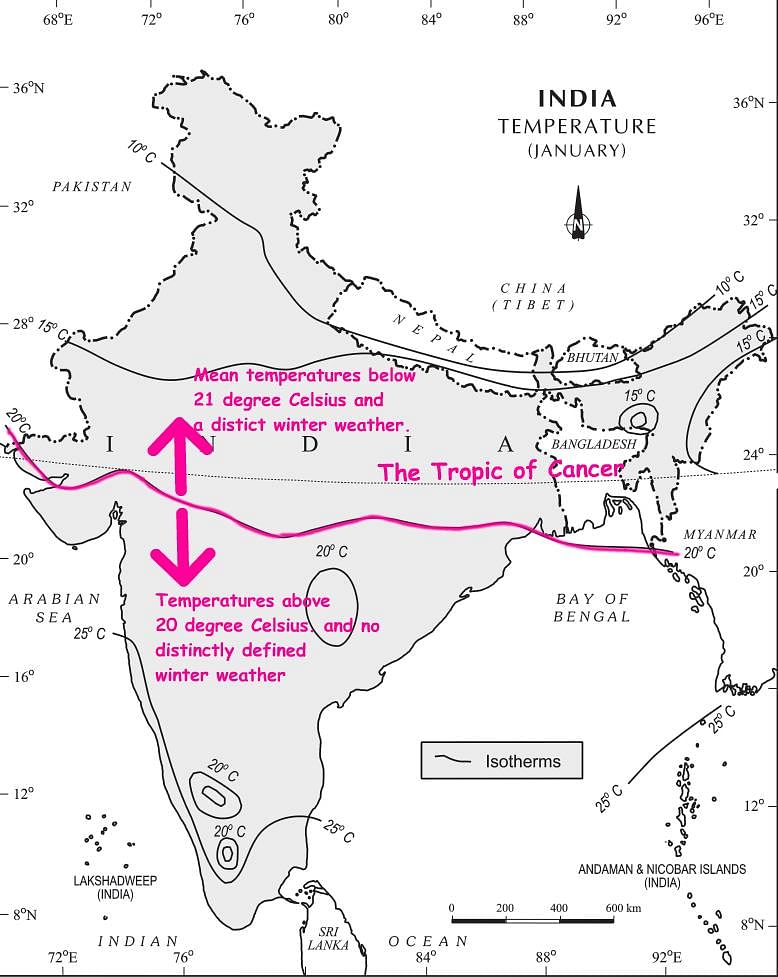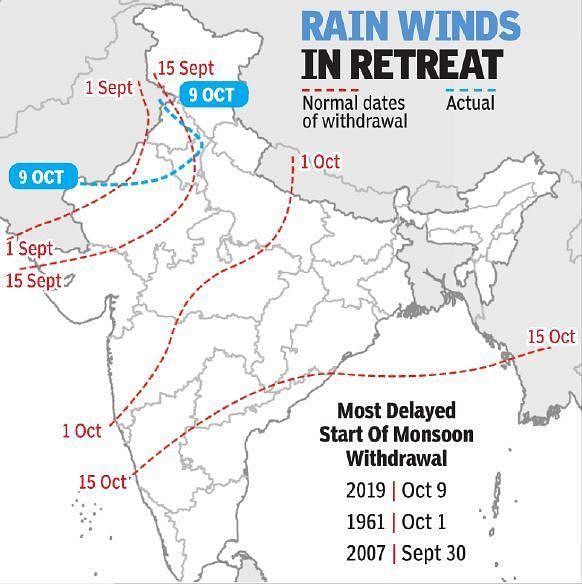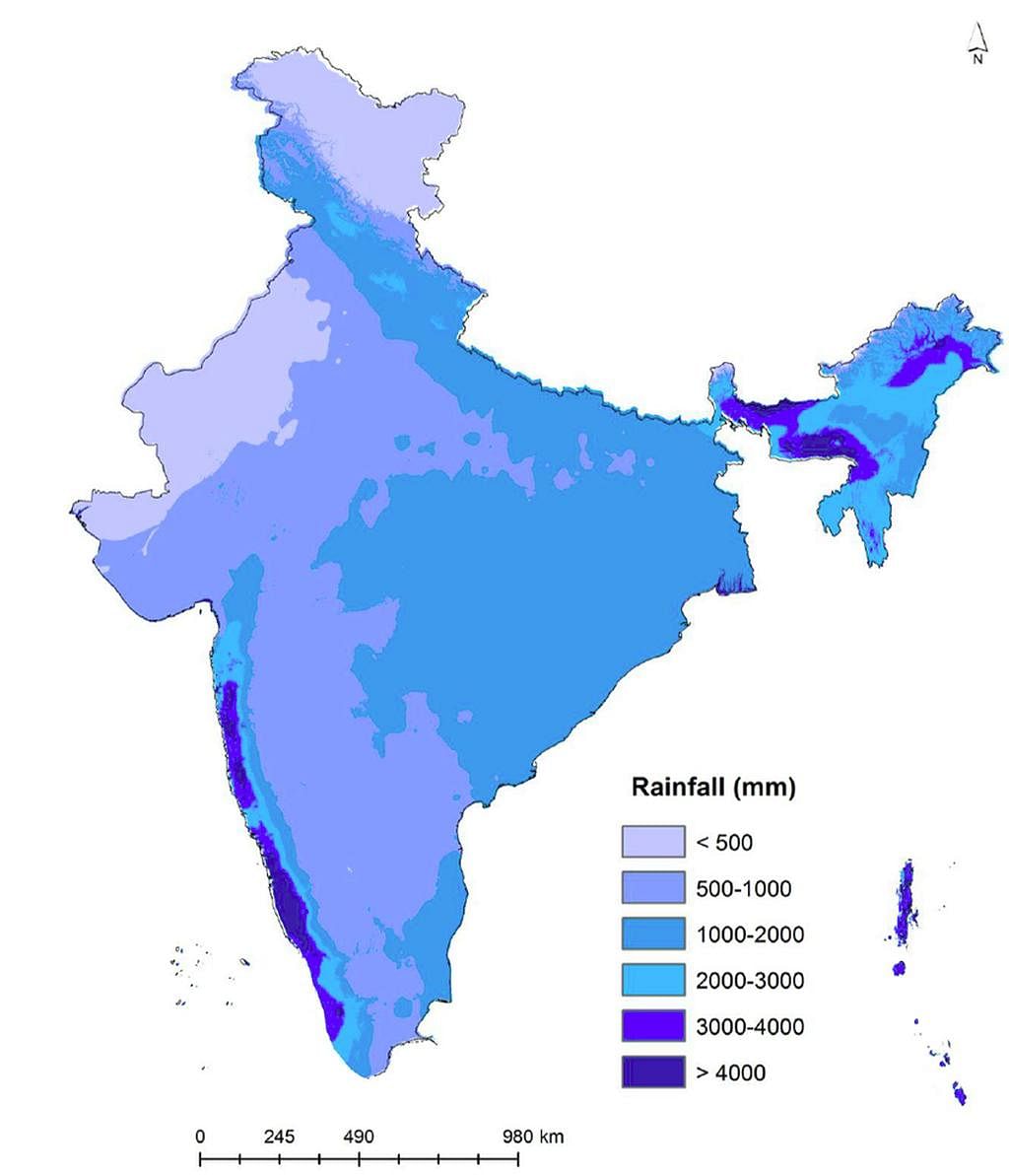NCERT Summary: Climate - 2 | Geography for UPSC CSE PDF Download
| Table of contents |

|
| Break in the Monsoon |

|
| The Rhythm of Seasons |

|
| The Cold Weather Season |

|
| The Hot Weather Season |

|
| Season of Retreating Monsoon |

|
Break in the Monsoon
During the south-west, monsoon period after having rain for a few days, it rain fails to occur for one or more weeks, it is known as break in the monsoon. These dry spells are quite common during the rainy season.
These breaks in the different regions are due to different reasons:
- In northern India, rains are likely to fail if the rain-bearing storms are not very frequent along the monsoon trough or the ITCZ over this region.
- Over the west coast, the dry spells are associated with days when winds blow parallel to the coast.
The Rhythm of Seasons
The climatic conditions of India can best be described in terms of an annual cycle of seasons:
➢ The Meteorologists Recognize the Following Four Seasons
- The Cold Weather Season
- The Hot Weather Season
- The Southwest Monsoon Season
- The Retreating Monsoon Season
➢ Some Famous Local Storms of Hot Weather Season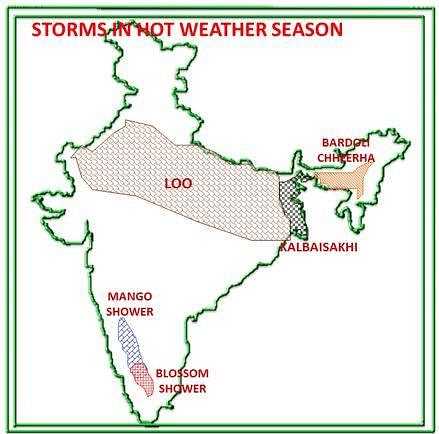
- Mango Shower: Towards the end of summer. There are pre-monsoon showers which are a common phenomenon in Kerala and coastal areas of Karnataka. Locally, they are known as mango showers since they help in the early ripening of mangoes.
- Blossom Shower: With this shower, coffee flowers blossom in Kerala and nearby areas.
- Nor Westers: These are dreaded evening thunderstorms in Bengal and Assam. Their notorious nature can be understood from the local nomenclature of ‘Kalbaisakhi’, a calamity of the month of Baisakh. These showers are useful for tea, Jute and rice cultivation. In Assam, these storms are known as “Bordoiseela”.
- Loo: Hot, dry and oppressing winds blowing in the Northern plains from Punjab to Bihar with higher intensity between Delhi and Patna.
The Cold Weather Season
➢ Temperature
- Usually, the cold weather season sets in by mid-November in northern India. December and January are the coldest months in the northern plain. The mean daily temperature remains below 21ºC over most parts of northern India. The night temperature may be quite low, sometimes going below freezing point in Punjab and Rajasthan.
 The Measure of Temperature in Winter
The Measure of Temperature in Winter
There are three main reasons for the excessive cold in north India during this season:
(i) States like Punjab, Haryana, and Rajasthan being far away from the moderating influence of sea experience continental climate.
(ii) The snowfall in the nearby Himalayan ranges creates cold wave situation.
(iii) Around February, the cold winds coming from the Caspian Sea and Turkmenistan bring cold wave along with frost and fog over the northwestern parts of India.
- The Peninsular region of India, however, does not have any well-defined cold-weather season. There is hardly any seasonal change in the distribution pattern of the temperature in coastal areas because of moderating influence of the sea and the proximity to equator.
Example: The mean maximum temperature for January at Thiruvananthapuram is as high as 31ºC, and for June, it is 29.5ºC. Temperatures at the hills of Western Ghats remain comparatively low.
➢ Pressure and Winds
- By the end of December (22nd December), the sun shines vertically over the Tropic of Capricorn in the southern hemisphere. The weather in this season is characterized by feeble high-pressure conditions over the northern plain. In south India, the air pressure is slightly lower. The isobars of 1019 mb and 1013 mb pass through northwest India and far south, respectively.
- As a result, winds start blowing from northwestern high-pressure zone to the low air pressure zone over the Indian Ocean in the south.
- Due to low-pressure gradient, the light winds with a low velocity of about 3-5 km per hour begin to blow outwards. By and large, the topography of the region influences the wind direction. They are westerly or northwesterly down the Ganga Valley. They become northerly in the Ganga-Brahmaputra delta. Free from the influence of topography, they are clearly northeasterly over the Bay of Bengal.
- During the winters, the weather in India is pleasant. The pleasant weather conditions, however, at intervals, get disturbed by shallow cyclonic depressions originating over the east Mediterranean Sea and traveling eastward across West Asia, Iran, Afghanistan and Pakistan before the reach the northwestern parts of India. On their way, the moisture content gets augmented from the Caspian Sea in the north and the Persian Gulf in the south.
➢ Role of Westerly Jet Stream
➢ Rainfall
Winter monsoons do not cause rainfall as they move from land to the sea. It is because firstly, they have little humidity, and secondly, due to anticyclonic circulation on land, the possibility of rainfall from them reduces. So, most parts of India do not have rainfall in the winter season.
However, there are some exceptions to it:
- In northwestern India, some weak temperate cyclones from the Mediterranean sea cause rainfall in Punjab, Haryana, Delhi and western Uttar Pradesh. Although the amount is meager, it is highly beneficial for rabi crops. The precipitation is in the form of snowfall in the lower Himalayas. It is this snow that sustains the flow of water in the Himalayan Rivers during the summer months.
- The precipitation goes on decreasing from west to east in the plains and from north to south in the mountains. The average winter rainfall in Delhi is around 53 mm. In Punjab and Bihar, rainfall remains between 25 mm and 18 mm respectively.
- Central parts of India and northern parts of southern Peninsula also get winter rainfall occasionally.
- Arunachal Pradesh and Assam in the northeastern parts of India also have rains between 25 mm and 50 mm during these winter months.
- During October and November, the northeast monsoon while crossing over the Bay of Bengal, pick up moisture and causes torrential rainfall over the Tamil Nadu coast, southern Andhra Pradesh, southeast Karnataka and southeast Kerala.
The Hot Weather Season
- With the apparent northward movement of the sun towards the Tropic of Cancer in March, temperatures start rising in north India. April, May and June are the months of summer in north India. In most parts of India, temperatures recorded are between 30º-32ºC.
- In March, the highest day temperature of about 38ºC occurs in the Deccan Plateau while in April, temperatures ranging between 38ºC and 43ºC are found in Gujarat and Madhya Pradesh. In May, the heat belt moves further north, and in the north-western part of India, temperatures around 48ºC are not uncommon.
- The hot weather season in south India is mild and not so intense as found in north India. The Peninsular situation of south India with moderating effect of the oceans keeps the temperatures lower than that prevailing in north India. So, temperatures remain between 26ºC and 32ºC.
- Due to altitude, the temperatures in the hills of Western Ghats remain below 25ºC. In the coastal regions, the north-south extent of isotherms parallel to the coast confirms that temperature does not decrease from north to south rather it increases from the coast to the interior. The mean daily minimum temperature during the summer months also remains quite high and rarely goes below 26ºC.
➢ Pressure and Winds
- The summer months are a period of excessive heat and falling air pressure in the northern half of the country. Because of the heating of the subcontinent, the ITCZ moves northwards occupying a position centred at 25ºN in July. Roughly, this elongated low-pressure monsoon trough extends over the Thar desert in the north-west to Patna and Chotanagpur plateau in the east-southeast.
- The location of the ITCZ attracts a surface circulation of the winds which are southwesterly on the west coast as well as along the coast of West Bengal and Bangladesh. They are easterly or southeasterly over north Bengal and Bihar. It has been discussed earlier that these currents of southwesterly monsoon are in reality ‘displaced’ equatorial westerlies.

- The influx of these winds by mid-June brings about a change in the weather towards the rainy season.
- In the heart of the ITCZ in the northwest, the dry and hot winds known as ‘Loo’, blow in the afternoon, and very often, they continue to well into midnight. Dust storms in the evening are very common during May in Punjab, Haryana, Eastern Rajasthan, and Uttar Pradesh.
- These temporary storms bring a welcome respite from the oppressing heat since they bring with them light rains and a pleasant cool breeze. Occasionally, The moisture-laden winds are attracted towards the periphery of the trough. A sudden contact between dry and moist air masses gives rise to local storms of great intensity. These local storms are associated with violent winds, torrential rains, and even hail storms.
The Southwest Monsoon Season
- As a result of rapid increase of temperature in May over the northwestern plains, the low-pressure conditions over there get further intensified. By early June, they are powerful enough to attract the trade winds of Southern Hemisphere coming from the Indian Ocean.
- These southeast trade winds cross the equator and enter the Bay of Bengal and the Arabian Sea, only to be caught up in the air circulation over India. Passing over the equatorial warm currents, they bring with them moisture in abundance. After crossing the equator, they follow a southwesterly direction. That is why they are known as southwest monsoons.
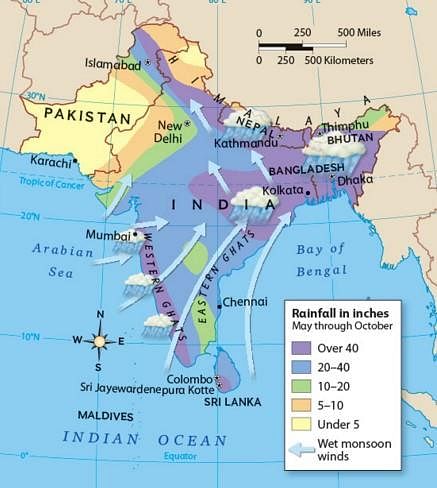
- The rain in the southwest monsoon season begins rather abruptly. One result of the first rain is that it brings down the temperature substantially. This sudden onset of the moisture-laden winds associated with violent thunder and lightning is often termed as the “break” or “burst” of the monsoons.
- The monsoon may burst in the first week of June in the coastal areas of Kerala, Karnataka, Goa and Maharashtra while in the interior parts of the country, it may be delayed to the first week of July. The day temperature registers a decline of 5ºC to 8ºC between mid-June and mid-July.
- As these winds approach the land, their southwesterly direction is modified by the relief and thermal low pressure over northwest India.
The monsoon approaches the landmass in two branches:
(i) The Arabian Sea branch
(ii) The Bay of Bengal branch
➢ Monsoon Winds of the Arabian Sea Monsoon Winds of the Arabian Sea
Monsoon Winds of the Arabian Sea
The monsoon winds originating over the Arabian Sea further split into three branches:
(i) Its one branch is obstructed by the Western Ghats. These winds climb the slopes of the Western Ghats from 900-1200 m. Soon, they become cool, and as a result, the windward side of the Sahyadris and Western Coastal Plain receive very heavy rainfall ranging between 250 cm and 400 cm. After crossing the Western Ghats, these winds descend and get heated up. This reduces humidity in the winds. As a result, these winds cause little rainfall east of the Western Ghats. This region of low rainfall is known as the rain-shadow area.
(ii) Another branch of the Arabian sea monsoon strikes the coast north of Mumbai. Moving along the Narmada and Tapi river valleys, these winds cause rainfall in extensive areas of central India. The Chotanagpur plateau gets 15 cm rainfall from this part of the branch. Thereafter, they enter the Ganga plains and mingle with the Bay of Bengal branch.
(iii) The third branch of this monsoon wind strikes the Saurashtra Peninsula and the Kachchh. It then passes over west Rajasthan and along the Aravallis, causing only a scanty rainfall. In Punjab and Haryana, it too joins the Bay of Bengal branch. These two branches, reinforced by each other, cause rains in the western Himalayas.
➢ Monsoon Winds of the Bay of Bengal
 Monsoon Winds of Bay of Bengal
Monsoon Winds of Bay of Bengal
- The Bay of Bengal branch strikes the coast of Myanmar and part of southeast Bangladesh. But the Arakan Hills along the coast of Myanmar deflect a big portion of this branch towards the Indian subcontinent. The monsoon, therefore, enters West Bengal and Bangladesh from south and southeast instead of from the south-westerly direction.
- From here, this branch splits into two under the influence of the Himalayas and the thermal low is northwest India. Its one branch moves westward along the Ganga plains reaching as far as the Punjab plains. The other branch moves up the Brahmaputra valley in the north and the northeast, causing widespread rains.
- Its sub-branch strikes the Garo and Khasi Hills of Meghalaya. Mawsynram, located on the crest of Khasi hills, receives the highest average annual rainfall in the world.
- Here it is important to know why the Tamil Nadu coast remains dry during this season.
- There are two factors responsible for it:
(i) The Tamil Nadu coast is situated parallel to the Bay of Bengal branch of southwest monsoon.
(ii) It lies in the rain shadow area of the Arabian Sea branch of the southwest monsoon.
Characteristics of Monsoonal Rainfall
- Rainfall received from the southwest monsoons is seasonal in character, which occurs between June and September.
- Monsoonal rainfall is largely governed by relief or topography. For instance, the windward side of the Western Ghats register a rainfall of over 250 cm. Again, the heavy rainfall in the northeastern states can be attributed to their hill ranges and the Eastern Himalayas.
- The monsoon rainfall has a declining trend with increasing distance from the sea. Kolkata receives 119 cm during the southwest monsoon period, Patna 105 cm, Allahabad 76 cm and Delhi 56 cm.
- The monsoon rains occur in wet spells of few days, duration at a time. The wet spells are interspersed with rainless intervals known as ‘breaks’. These breaks in rainfall are related to the cyclonic depressions mainly formed at the head of the Bay of Bengal, and their crossing into the mainland. Besides the frequency and intensity of these depressions, the passage followed by them determines the spatial distribution of rainfall.
- The summer rainfall comes in a heavy downpour leading to considerable run off and soil erosion.
- Monsoons play a pivotal role in the agrarian economy of India because over three-fourths of the total rain in the country is received during the southwest monsoon season.
- Its spatial distribution is also uneven which ranges from 12 cm to more than 250 cm.
- The beginning of the rains sometimes is considerably delayed over the whole or a part of the country.
- The rains sometimes end considerably earlier than usual, causing great damage to standing crops and making the sowing of winter crops difficult.
Season of Retreating Monsoon
- The months of October and November are known for retreating monsoons. By the end of September, the southwest monsoon becomes weak as the low pressure trough of the Ganga plain starts moving southward in response to the southward march of the sun. The monsoon retreats from western Rajasthan by the first week of September.
- It withdraws from Rajasthan, Gujarat, Western Ganga plain, and the Central Highlands by the end of the month. By the beginning of October, the low pressures cover northern parts of the Bay of Bengal and by early November, it moves over Karnataka and Tamil Nadu. By the middle of December, the centre of low pressure is completely removed from the Peninsula.

- The retreating southwest monsoon season is marked by clear skies and a rise in temperature. The land is still moist. Owing to the conditions of high temperature and humidity, the weather becomes rather oppressive. This is commonly known as the ‘October heat’. In the second half of October, the mercury begins to fall rapidly, particularly in northern India.
- The weather in the retreating monsoon is dry in north India but it is associated with rain in the eastern part of the Peninsula. Here, October and November are the rainiest months of the year. The widespread rain in this season is associated with the passage of cyclonic depressions which originate over the Andaman Sea and manage to cross the eastern coast of the southern Peninsula. These tropical cyclones are very destructive.
- The thickly populated deltas of the Godavari, Krishna and Kaveri are their preferred targets. Every year cyclones bring disaster here. A few cyclonic storms also strike the coast of West Bengal, Bangladesh and Myanmar. A bulk of the rainfall of the Coromandal coast is derived from these depressions and cyclones. Such cyclonic storms are less frequent in the Arabian Sea.
➢ Distribution of Rainfall
- The average annual rainfall in India is about 125 cm, but it has great spatial variations.

- Areas of High Rainfall: The highest rainfall occurs along the west coast, on the Western Ghats, as well as in the sub-Himalayan areas is the northeast and the hills of Meghalaya. Here the rainfall exceeds 200 cm. In some parts of Khasi and Jaintia hills, the rainfall exceeds 1,000 cm. In the Brahmaputra valley and the adjoining hills. The rainfall is less than 200 cm.
- Areas of Medium Rainfall: Rainfall between 100-200 cm is received in the southern parts of Gujarat, east Tamil Nadu, northeastern Peninsula covering Orissa, Jharkhand, Bihar, eastern Madhya Pradesh, northern Ganga plain along the sub-Himalayas and the Cachar Valley and Manipur.
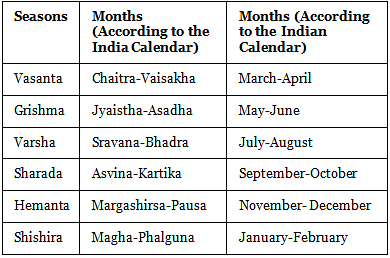
- Areas of Low Rainfall: Western Uttar Pradesh, Delhi, Haryana. Punjab, Jammu and Kashmir, eastern Rajasthan, Gujarat, and Deccan Plateau receive rainfall between 50-100 cm.
- Areas of Inadequate Rainfall: Parts of the Peninsula, especially in Andhra Pradesh, Karnataka and Maharashtra, Ladakh, and most of western Rajasthan receive rainfall below 50 cm. Snowfall is restricted to the Himalayan region.
|
180 videos|475 docs|198 tests
|
FAQs on NCERT Summary: Climate - 2 - Geography for UPSC CSE
| 1. What is the significance of the monsoon season in India? |  |
| 2. How does the monsoon season affect the climate in India? |  |
| 3. What are the characteristics of the hot weather season in India? |  |
| 4. How does the cold weather season differ from the hot weather season in India? |  |
| 5. What is the role of the retreating monsoon season in India? |  |

|
Explore Courses for UPSC exam
|

|
